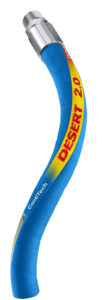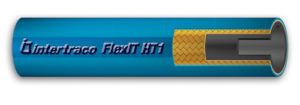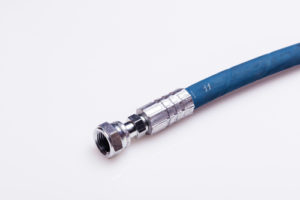
In a previous posting, the editors at Fluid Power World discussed how ultra-low temperatures can play havoc with the performance of typical rubber hose. Hydraulic hose used at high temperatures faces performance issues too, but for different reasons.
That’s because thermal exposure can cause aging of elastomers and plastics. (Other causes of aging include exposure to sunlight, oxygen, ozone and moisture, among others.) Thus, the polymers that make up the cover, inner tube and possibly the reinforcement can be at risk.
Extreme heat can affect plastics in two ways, both of which are bad. Properties can be degraded by molecular chain growth and crosslinking, which usually decreases elongation and increases tensile strength—resulting in a hard, brittle material. Or high heat causes chain rupture, which results in a weaker, more-pliable plastic or even a resinous mass. When exposed to elevated temperatures, some plastics will even show an initial hardening followed by softening. All aging phenomena are irreversible processes.
Nearly all plastics exhibit some degree of mechanical property degradation as temperatures increase. The same holds for hydraulic hose. Extremely high temperatures can affect a hose’s elastomeric and mechanical properties and cause problems like softening, discoloration, embrittlement or hardening. One visible indication of degradation is thermal-stress cracking, the crazing of some thermoplastic resins resulting from overexposure to elevated temperatures. The cover may show signs of being dried out and charred or even crack when flexed. The assembly may remain “frozen” in its installed shape after it’s removed from a machine.
Hot fluids beyond recommended temperature limits may have a similar, detrimental effect on the inner tube. (Failure to use hydraulic oil with the necessary high-temperature viscosity can also accelerate hose degradation.) And non-petroleum hydraulic fluids like water/oil emulsions and glycol solutions sometimes require lower temperature limits. Regardless, never exceed the recommended maximum operating temperature for a given fluid. If hose maximums for ambient and fluid temperatures differ, the lower limit takes precedence.
Some manufacturers say increasing external temperature by just 18° F (8° C) above maximum rated temperature can cut hose life in half. Actual service life at temperatures approaching the hose’s recommended limit depends on the application and fluid. But simultaneously operating at maximum temperature and maximum working pressure can greatly reduce hose life.
Likewise, radiant heat from furnaces, hot manifolds and molten metal can destroy hose assemblies without physical contact. And welding flames or spatter can burn through a hose. Engineers should select a hose that is designed for temperature extremes and ensure it is properly shielded. Reroute hose away from heat sources if at all possible. If high fluid temperature poses a problem, redesign the circuit so it is more efficient or install a heat exchanger to reduce fluid temperature.
At any rate, experts recommend that hose assemblies exposed to high-temperature conditions should be inspected frequently for any signs of deterioration, and damaged assemblies should be immediately replaced with ones with a higher temperature rating.
 Hose manufacturers have developed heat-resistant products to meet these demands. For instance, they often specify thermally stable polymers, or add heat stabilizers, for use in hot conditions. One example is hose that uses chlorinated polyethylene (CPE) to replace traditional nitrile tube. CPE can handle constant temperatures to 275° F and intermittent temperatures of 300° F, while typical nitrile limitations are 212° and 230° F, respectively.
Hose manufacturers have developed heat-resistant products to meet these demands. For instance, they often specify thermally stable polymers, or add heat stabilizers, for use in hot conditions. One example is hose that uses chlorinated polyethylene (CPE) to replace traditional nitrile tube. CPE can handle constant temperatures to 275° F and intermittent temperatures of 300° F, while typical nitrile limitations are 212° and 230° F, respectively.
Rubber blends in typical hydraulic hose are rated for operation to 212° F (100° C). However, a number of hose manufactures offer a wide range of products suitable for higher temperatures. Here are a few examples:
ContiTech (www.contitech.us) Desert DR2SN is a two-wire braid reinforced hose that meets or exceeds the requirements of SAE 100R2AT. It is suited for high-pressure hydraulic lines in construction and ag equipment and machine tools that use high-temperature petroleum or water-based fluids. It has a CPE inner tube and blue CPE cover. Temperature range is -40° to 302° F (-40° to 150° C). Sizes range from -4 to -32 with pressure ratings from 5,800 to 1,160 psi, depending on the size.
 Gates (www.gates.com) MegaTech II is a multi-purpose hose for high-temperature (maximum 300° F or 149° C) applications with petroleum-based or phosphate-ester hydraulic fluids, as well as for air-compressor lines. It also meets SAE J1405 specs for high-temperature transmission and lubricating oil systems. Versions with two-wire braid reinforcement come in sizes -24 to -32 and meet SAE 100R2 requirements. It has a CPE synthetic rubber tube and abrasion-resistant CPE cover. Operating pressure range is from 2,250 to 1,300 psi.
Gates (www.gates.com) MegaTech II is a multi-purpose hose for high-temperature (maximum 300° F or 149° C) applications with petroleum-based or phosphate-ester hydraulic fluids, as well as for air-compressor lines. It also meets SAE J1405 specs for high-temperature transmission and lubricating oil systems. Versions with two-wire braid reinforcement come in sizes -24 to -32 and meet SAE 100R2 requirements. It has a CPE synthetic rubber tube and abrasion-resistant CPE cover. Operating pressure range is from 2,250 to 1,300 psi.

Intertraco (intertraco.it) FlexIT HT1 one-wire braid hose is rated for use with hydraulic oils at temperatures from -40° to 275° F (-40° to 135° C), with peaks to 302° F (150° C). For polyglycols, peak temperature is 185° F (85° C). It is also suited for plant-based oils, water-oil emulsions and water. The hose has a synthetic rubber tube and MSHA-approved synthetic rubber cover. Sizes are from -4 to -32.

Eaton (www.eaton.com) EC525 AQP Plus high-temperature, four-spiral hose is suitable for petroleum, fire-resistant and water-based hydraulic fluids. Its AQP compound for the inner tube and cover gives it an operating temperature range from -40° to 302° F (-40° to 150° C). Sizes range from -12 to -32 with maximum operating pressure ranging from 5,000 to 3,250 psi.

Manuli (www.manuli-hydraulics.com) Equator/2 extreme-temperature hose is rated for continuous service temperatures of -55° to 135° C (-67° to 275° F) with intermittent peaks to 300° F (150° C). It’s suited for hot conditions, such as in foundries and engine compartments. It has two-wire braid (SAE R2AT) construction in sizes from -4 to -32 with maximum working pressure from 5,800 to 1,300 psi. The hose handles mineral oils, glycols and aqueous emulsions.
Ryco (www.ryco.com.au) RQP2 is one of the company’s Survivor Series of hydraulic hoses. With a synthetic rubber tube and abrasion-resistant synthetic rubber cover, the RQP2 is rated for -40° to 302° F (-40° to 150°C). It’s a two-wire braid construction that meets or exceeds performance requirements of SAE 100R2AT for hydraulic oil or phosphate-ester fluids. Sizes range from -4 to -32 and pressures from 5,800 to 1,300 psi.

Parker Hannifin (www.parker.com) 436 hose withstands temperatures up to 302° F (150° C). The inner tube and cover are made of PKR rubber, and it has two-wire braided reinforcement that meets SAE 100R16 specifications. Sizes range from -6 to -16 with operating pressures from 4000 to 2000 psi.

I need a Hydraulic Hose 10,000 PSI it will be used in a extreme welding environment ( Gas Pipeline construction) The splatter from the welding is puncturing our current hose. Our products use Enerpac and Rampac Tools . Would you have any thing we could use?
Hi Brian – A number of major hose manufacturers, including Eaton, Gates and Parker to name just a few, make high-pressure hoses. In extreme conditions, hose may need additional shielding or safeguarding. Check out our story, “How do you protect hydraulic hose,” for additional information. https://www.fluidpowerworld.com/protect-hydraulic-hose/
Thank you for reading!
Hi Mary,
Do you mind sharing how to be listed in your supplier directory?
Regards
Vincent